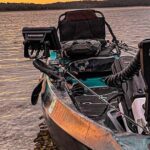When you try to find a charger for trolling motor batteries, there are numerous choices to pick from, which could make your selection more complex.
In order to make the choice easier, we have collected data that may be of value when selecting your next charger. We will examine the different sorts of chargers and some of the elements you should be aware of.
The most important thing to consider first is what type of battery you require for your trolling motor.
Trolling Motor Battery Types
There are several types of trolling motor batteries:
Lead Acid Wet-Cell battery power has been widely used in marine applications for several decades. They can take a lot of charge/discharge cycles, have a life of approximately 2-3 years, and are usually cost effective.
Nonetheless, they have to be routinely looked after (as basic as refilling the liquid in the battery) and they might spurt, drip, or shake excessively. These are definitely affordable options, but not the best of the best.
Absorbed Glass Mat (AGM) batteries are complete and unopened containers of acid that are filled with lead plates. Manufacturers usually make batteries designated for cars to use, but they can modify them so that they can power small boat motors as well.
Very little upkeep is needed for them, and they will usually keep running for 3-4 years, however they can be quite expensive.
Lithium Iron (LiPoFe4) batteries are increasingly trendy, and the prices have been dropping significantly. They are more lightweight and petite than the other two types of battery compared, having a lifespan of up to 10 years and the capacity to be totally discharged (all energy used up) instead of a weaker decline in power witnessed with lead-acid/AGM batteries. Lithium batteries provide more juice but occupy much less room in your kayak.
We highly suggest purchasing lithium trolling motor batteries as your top choice. They’re more durable, reliable, and longer-lasting. In addition, the cost of these batteries is reducing, making them very competitive in price with other trolling motor batteries.
It is a wise decision to invest a few extra dollars to purchase a battery of a higher standard.
Understanding Trolling Motor Battery Voltage
A lot of people find it simple to grasp that bigger engines need more electricity.
Motors for trolling can be sufficiently powerful to necessitate the use of 36-volt batteries. Although trolling motors for kayaks are mostly of a diminutive size, they are able to generate an amount of thrust ranging from 18 to 55 pounds, and the power requirements for them are typically in the form of a 12-volt battery.
Be aware that the majority of trolling motors that are usually employed on a kayak are made to work with a 12-volt battery. If you connect a 24-volt battery to your 12-volt motor, you risk causing it to overheat, resulting in damage to the engine’s system components, wires and controller.
Using a 12-volt battery to operate a 24-volt trolling motor is not advisable, as it can put too much strain on the motor due to an insufficient supply of voltage. If you own a trolling motor with a 24-volt charge, then you’ll need either two 12-volt batteries or one 24-volt battery in order to get enough power.
Verify the wattage on your trolling motor before acquiring a battery, and you can prevent probable damage that could have been bypassed without difficulty!
Trolling Motor Battery Maintenance Tips
Keep your trolling motor battery in tip-top shape by:
Charging to 100% on your first use. When you first get the battery, charge it completely without any interruptions or breaks. The producers usually inspect the batteries already, but it is essential to make sure that you can charge the battery all the way up to full capacity, or else you will have to get a new one!
Always charging to 100%. If you don’t charge your battery properly, it can cause harm to the internal parts due to excessive gas formation and layering.
Maintaining it above 80% charge. This contributes to preserving the battery’s lifespan and ensures that it is continually recharged and available for use at anytime.
Never storing the battery discharged. Keeping a battery that is no longer functional will detrimentally affect its total duration and likely lessen its storage and results.
Preserving the battery from both severely cold and excessively hot temperatures will have an effect on its performance. Temperatures greater than 80 degrees Fahrenheit and below zero can affect how it works and reduce its life expectancy.
In the winter months when it’s chilly and during the summertime when it’s scorching hot, keep it in your home that has heating or air conditioning.
Watering your wet-cell battery regularly. Pick a wet-cell battery and ensure it runs at its best by replenishing it with purified water on a regular basis.
5 Best Trolling Motor Battery Chargers
1: Minn Kota On-Board Digital Charger (Best On-Board Charger)
If you plan to bring a charger along on your kayak or small vessel, the Minn Kota On-Board Digital Charger may be the ideal solution. It might be a bit bulky and large (17 ¼ by 6 ½ inches), so wouldn’t be the best option if space in your luggage is restricted.
- Waterproof – These chargers are designed to be waterproof, shock-resistant and vibration resistant so that they can handle the conditions aboard your boat.
- Types Of Batteries – Designed to work with AGM, wet cell and maintenance free batteries. Compatible with systems from 12 volts up to 48 volts using 12 volt/6 cell batteries.
- Digital – The charger features microprocessors to help deliver the correct amount of charge to your battery. This means it won’t overcharge or undercharge your battery, which can help maintain the longevity of your battery. It also features automatic multi-stage charging depending on the level of charge your battery has, including a trickle charge to keep the battery maintained during periods where you’re not using it.
- LED Display – These LED lights can let you see where your battery is in the charging process, so you know when it’s full or if even there’s a connection issue.
- 3 Banks – This charger benefits from having three banks so it can charge three different batteries at the same time, making it great for three-battery trolling motor systems or if you have other gadgets you need to keep charged on the water. Each bank can deliver 10 amps.
2: Noco Genius2 2-Amp Smart Precision Charger (Best Precision Charger)
The Noco Genius2 charger is a smart and accurate device that is suitable for various 6 volt and 12 volt batteries. Due to its small size of only 6 inches, this product can be beneficial for situations in which the available space is limited.
- Built-In Thermal Sensor – This helps to deliver precision charging, altering the level of charge in both hot and cold temperatures so that the battery can still be charged to its full capacity.
- Auto-Detection Feature – The charger can automatically detect sulfation and acid stratification. It’s also designed to repair and reverse damage to bring dead batteries back to life.
- Maintenance – It’s also designed to maintain batteries, delivering a trickle charge when needed so that you can prevent the battery from draining if it’s not in use for a long period of time.
- Multi-Voltage – the charger benefits from being able to detect the type and voltage of battery. This can automatically identify the battery and can be used on a variety of types of batteries, including lithium ion batteries, AGM, wet-cell and deep cycle batteries.
3: Optima Digital 400 12-Volt Charger (Best Digital Charger)
The Optima Digital 400 charger was made to be compatible with 12V batteries, covering wet cell, AGM, and deep-cycle marine batteries. This product is very small, being just over 8 inches, so it can be placed in any boat or vehicle without taking up much space.
- LED Display – The handy LED lights and LCD display can let you select your battery type and see when it’s fully charged.
- Built-In Battery Health Mode – This can automatically detect the health of your battery and can maximize its lifespan, delivering a trickle charge automatically as needed when the battery is not in use. It can also deliver as low as 1.25 amps to restart a dead battery.
- One Bank – This compact charger has one bank so you can only charge one battery at a time but can be ideal for trolling motor systems that use only one battery. The bank has an output of 4 amps.
4: Duravolt 20 Watt 1.0 Amp Solar Battery Charger (Best Solar Charger)
Using a Duravolt 20 Watt solar charger is an excellent choice for charging your battery while travelling. This solar panel has four holes around the periphery of the frame that make mounting it onto any flat surface on your boat a breeze.
- Low Profile – The solar panel measures 14 by 16 inches and is just ¼ inch thick so it shouldn’t take up much room on your vessel if you install it on a flat area of your deck.
- Waterproof – The charger is designed to be waterproof so that it can withstand rain and splashes. It’s also built to be durable and may be able to withstand some light impact, such as from gear bags being placed on top of it, for example.
- Solar Power – The durable solar panel comes with everything you need to be able to connect the charger to a 12 volt battery, harnessing the power of the sun. The level of charge it can deliver will depend on how much sunlight there is, which may be significantly less in the darker winter months or on cloudy days.
- Trickle Charge – The charger can also be used to deliver a trickle charge to your battery. However this is not automatic and won’t necessarily adjust the level of charge to correspond with the level your battery needs.
5: Minn Kota MK-105P Portable Battery Charger (Best Portable Charger)
This Minn Kota MK-105P is a perfect mobile charger with a single bank, perfect for keeping your battery charged while you’re on the go. This item is convenient to carry or store due to its small size, ideal for limited spaces on your vessel.
- Smart Charging – The charger is designed to optimize battery life and prevent short circuits. Its built-in technology means that your battery won’t be undercharged or overcharged. It’s also built to prevent malfunctions from incorrect connections.
- LED Lights – The lights let you know when the battery is fully charged and that it’s connected correctly.
- One Bank – This charger has one bank that can deliver 5 amps, making it convenient for one-battery trolling motor systems.
- Carry Handle – The Minn Kota MK-105P has a useful molded carrying handle so that it’s easier to move from place to place. The charger measures 8 by 8 by 7 inches so it’s compact and easy to carry.
How To Choose A Charger For Your Trolling Motor Battery
Number Of Banks
The amount of ports a charger possesses is correlated to how many batteries can be charged simultaneously. As an example, having two batteries in your trolling motor would necessitate choosing a charger with two banks as this allows for both batteries to be charged simultaneously.
A smart move when you are outfitting your trolling motor is to get a charger that has a number of banks equal to the number of batteries you will be using; this will help maximize efficiency.
Time To Recover
The amount of time necessary for the power pack to be powered up typically depends on the amperage of the recharger and the size of the battery. A battery that has a smaller amp rating will usually take a shorter time to charge in comparison to a battery with a larger amp rating.
It is common for a battery to be completely charged in 10 to 12 hours with most chargers, but some may be able to do it even faster. Utilizing a battery charger that is suitable for your battery can be more secure than one with an amperage rating beyond that of your battery.
Last Words
Prior to immediately investing in a charger, make sure to confirm that the charger is compatible with the exact model and size of battery you have. Not all batteries can be charged with these chargers.
It may be advantageous to purchase a charger with more ports if your trolling motor has multiple batteries, as that can speed up the charging process.




